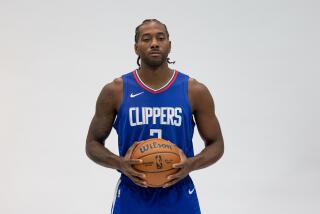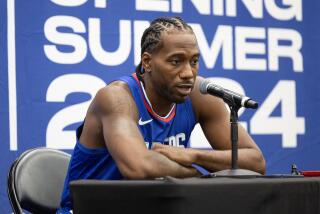Eating Away at Problem : After Losing Nearly 60 Pounds, Williams Is a Happy Clipper
- Share via
John Williams of the Clippers stared at himself in the mirror and smiled.
He almost didn’t recognize himself after having lost nearly 60 pounds in four months.
Williams, a 6-foot-9 forward-center, weighed 330 pounds when he entered the Duke University Diet and Fitness Center last October. He was put on the suspended list by the Clippers before the season opened.
Activated by the Clippers on Feb. 4, having sat out the first 42 games of the season, Williams said he weighed 276 pounds and wanted to shed six more.
“I feel great now,” Williams said. “I can look in the mirror and say ‘Hey, you’ve done something nice.’ I see myself now and see a totally different person.
“I’ve still got my old clothes and sometimes I’ll try them on and just stand there dazed when I realize how much weight I’ve lost. When I first got back and tried on a pair of my pants, they were four inches too big.”
Williams’ battle of the bulge began when he suffered a season-ending knee injury 18 games into the 1989-90 season. Averaging a career-high 18.2 points at the time for the Washington Bullets, he suffered two torn ligaments in his right knee while chasing a loose ball.
“I was ranging from 250 to 260 pounds before I got hurt, but I was in a full cast for three months and I wasn’t able to do anything,” he said. “I just started gaining weight. I’ve always had the problem of going up and down in weight, and I just got out of control.”
Williams also had emotional problems.
He was devastated because two of his closest friends, Melvin Maxwell and Greg Braggs, had died suddenly within a year.
Maxwell, who had befriended Williams when he attended Louisiana State, was killed in a gang-related shooting in Oakland in the summer of 1989. Bragg, who had played with Williams at Crenshaw High, drowned while jet skiing at Marina Del Rey in the summer of 1990.
“Melvin was like a brother to me,” Williams said. “He wasn’t in a gang, but it was a case of mistaken identity. Someone pulled up next to him in a car and just shot the whole car up. He was shot five or six times.”
Williams took the deaths hard.
“John blamed himself for both deaths,” said Fayne Pitts, Williams’ fiancee. “Melvin used to live with John, and then when we got engaged . . . that’s when Melvin moved out and got into trouble. (Williams) blamed himself for the death because he kind of pushed him out. And he blamed himself for Greg’s drowning because he didn’t push Greg to wear a life jacket. John stood on the beach and watched him drown.”
Williams turned to junk food and liquor to ease the pain.
“It was real depressing because we were so tight,” Williams said. “Any time you would see me, you would see one of them. . . . It was devastating. I started drinking, eating and hanging out late at night. I wasn’t concentrating on getting back out on the court and taking care of my life, and it just got the best of me.
“I don’t know if I had a drinking problem, but I was drinking a lot. And it didn’t mix with trying to lose weight. I’d drink a six pack (a day) or sometimes more.
“I was isolated and by myself a lot. I didn’t want to be around a lot of people and didn’t want to talk to anyone. I was real frustrated and depressed.
“Sometimes I’d just get up and go to the beach and watch the water because it was relaxing. I’d take some fried chicken and burgers and go pig out there.
“I felt real relaxed when I was eating because it was the only time when I could just shut everybody out.”
He also wasn’t committed to his rehabilitation program and worked out irregularly.
“I just took everything for granted,” Williams said. “I figured that things would work out with time, but I wasn’t putting out the effort to get back.”
Williams returned to the Bullet lineup on Feb. 12, 1991--he had been sidelined for 112 games--and averaged 12.5 points, 5.4 rebounds and four assists in 33 games.
But the Bullets suspended him for the entire 1991-92 season because he was overweight and out of shape.
“They had reason to suspend me because I wasn’t putting out the effort that was expected of me,” Williams said. “In a way, I’m glad everything turned out like it did. You have to go through problems to get stronger in life.”
Williams got a second chance when Washington traded him to the Clippers for the draft rights to former UCLA forward Don MacLean and center William Bedford on Oct. 8, 1992.
Former Clipper coach Larry Brown was instrumental in the acquisition of Williams.
“He’s as good as any player I ever coached in his understanding of the game and his unselfishness and his ability, and I really mean that,” Brown said. “I’ve always thought he was a pretty special player and person.”
Joining the Clippers was a homecoming for Williams, who had averaged 28.7 points, 14.1 rebounds, 4.7 assists and 3.5 steals in leading Crenshaw High to the 1984 State championship.
Williams, who weighed 300 pounds last season, struggled, averaging a career-low 6.6 points, 4.3 rebounds and 1.9 assists in 74 games.
“When I got traded here I was still way overweight,” Williams said. “But I saw it as another opportunity for me. I didn’t have the best of years last year, but I could say that I was in the league and most people can’t say that. I was in the league at 300 pounds. Not too many people could do that.
“Man, I don’t know how I did it last year, but I got away with it last year. There were days where I felt real sluggish. I didn’t feel good about myself as an individual.”
Brown agreed.
“I don’t think he’s anywhere near as effective as he would be if he were at a reasonable weight,” Brown said. “And that’s something he’s trying to deal with.
“But before anybody can do anything about (losing weight), you have to come to grips with it. I thought John tried, but it still wasn’t to the point where he knew he needed to do it. And I think that happened this fall.
“And I’m proud of him, because it hasn’t been easy for him. Last year when I was coaching him, he could see things he knew he was capable of doing and he was playing against players he knew he could beat, and the fact that he wasn’t light enough or physically able frustrated him.”
When Brown left the Clippers to coach the Indiana Pacers, he tried to trade for Williams.
“We tried real hard to trade for him and thought we had a trade, but it fell through,” Brown said. “I continue to try to get John. I’d love to coach him again. As long as I’m in basketball, I’m going to do everything I can to get reunited with him.”
After Brown departed, the Clippers ordered Williams to lose weight, sending him to the Pritikin Center in Santa Monica.
He dropped out.
“I was willing to try anything,” Williams said. “I went to Pritikin, but the program is real difficult because they give you food that you wouldn’t eat every day, but at that time I was willing to try anything.”
He also tried a liquid diet, but failed.
Finally, Williams entered the Duke program by mutual consent with the Clippers.
“I wasn’t in shape to play basketball,” Williams said. “I’m not trying to fool nobody, trying to go out there and struggle like I did last year because this game is supposed to be fun.”
Williams was put on a low-fat, low-salt diet of 1,500-2,000 calories per day. He also worked out twice a day with a personal trainer, running on a treadmill and lifting weights.
“In the beginning, I didn’t (lose weight), but they told me that I had to stick with it because it wouldn’t happen overnight,” Williams said. “I stayed on the program and I started seeing results. (That) made me feel a lot better.
“They had some people down there who weighed 700 pounds and I was just one of them. A couple of people knew who I was, but I was the only professional athlete there.”
But he wasn’t particularly athletic.
“When I first got down there I couldn’t walk a mile,” he said. “I’d get too tired and my back and knees would start to hurt. But I kept pushing myself and I got to the point where I was running five miles a day and riding (an exercise) bike for an hour a day.”
Pitts helped motivate Williams.
“When he was away at Duke University, the way I used to get him to work out when I knew he was getting kind of bummed out was to call him up and tell him, ‘I’m tired of hearing people say that John Williams was a good player. You’re not a has-been,’ ” Pitts said. “Or I’d call him up and read him old (newspaper) articles from when he was playing with the Bullets.
“I’ve lost 25 pounds myself. I want to do it with him. When he’s home, I’ll go with him to the gym and I’ll eat what he has to eat.”
Clipper shooting coach Kiki Vandeweghe and Carl Horne, the team’s strength and conditioning coach, helped prepare Williams for his return to the NBA.
“He’s on a low-fat diet and lifting weights and practicing with the team every day, so his weight is continuing to drop,” Horne said.
“He knows that he can control his weight now. That was the main thing he had to figure out, because he’s just been out of control these past few years.”
Williams made an immediate contribution to the struggling Clippers. Starting against the Lakers last month, he had his best game as a Clipper, scoring 21 points.
More to Read
Go beyond the scoreboard
Get the latest on L.A.'s teams in the daily Sports Report newsletter.
You may occasionally receive promotional content from the Los Angeles Times.






